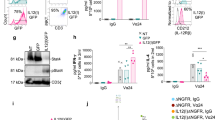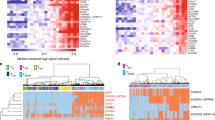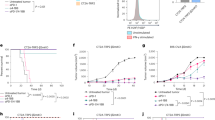Abstract
Inhibitory natural killer receptors (NKRs) such as killer cell immunoglobulin-like receptors (KIRs) in humans and Ly49 molecules in mice are expressed on NK cells and recognize multiple major histocompatibility (MHC) class I proteins. In humans and mice, a subset of CD8+ T cells also expresses NKRs and harbors a memory phenotype. Using mice that are transgenic for KIR2DL3 and its cognate HLA-Cw3 ligand, we show that engagement of inhibitory NKRs selectively drives the in vivo accumulation of a subset of memory-phenotype CD8+ T cells that express the β chain of the interleukin 2 receptor. In vitro, recognition of MHC class I molecules by inhibitory NKRs on T cells down-regulated activation-induced cell death. These results unveil an MHC class I–dependent pathway that promotes the survival of a subset of memory-phenotype CD8+ T cells and also reveal an unexpected biological function for inhibitory NKRs on T cells.
NOTE: Incorrect reference numbering appeared in both the original print and web versions of this article. The instances of these errors are marked by asterisks (*) in the online version. The errors are: (i) Ref. 28 was printed incorrectly and should be Ref. 31; (ii) Ref. 29 was printed incorrectly and should be Ref. 32; (iii) References 28–32 should read as follows: 28. Zajac, A. J. et al. Impaired Anti-viral T cell responses due to expression of the LY49A inhibitory receptor. J. Immunol. 163, 5526-5534 (1999). 29. Pauza, M. et al. Transgenic expression of Ly-49A in thymocytes alters repertoire selection. J. Immunol. 164, 884-892 (2000). 30. Fahlen, L. et al. Ly49A expression on T cells alters T cell selection. Int. Immunol. 12, 215-222 (2000). 31. Marti, F. et al. LCK-phosphorylated human killer cell-inhibitory receptors recruit and activate phosphatidylinositol 3-kinase. Proc. Natl Acad. Sci. USA. 95, 11810-11815 (1998). 32. Bieganowska, K. et al. Direct analysis of viral-specific CD8+ T cells with soluble HLA-A2/Tax11-19 tetramer complexes in patients with human T cell lymphotropic virus-associated myelopathy. J. Immunol. 162, 1765-1771 (1999). We apologize for any confusion this may have caused. The most updated version of the article is available in PDF format.
This is a preview of subscription content, access via your institution
Access options
Subscribe to this journal
Receive 12 print issues and online access
$209.00 per year
only $17.42 per issue
Buy this article
- Purchase on Springer Link
- Instant access to full article PDF
Prices may be subject to local taxes which are calculated during checkout







Similar content being viewed by others
References
Lanier, L. L. NK Cell Receptors. Ann. Rev. Immunol. 16, 359–393 (1998).
Long, E. O. Regulation of immune responses through inhibitory receptors. Annu. Rev. Immunol. 17, 875–904 (1999).
Tomasello, E., Bléry, M., Vély, F. & Vivier, E. Signaling pathways engaged by NK cell receptors: double concerto for activating receptors, inhibitory receptors and NK cells. Semin. Immunol. 12, 139–147 (2000).
Colonna, M. et al. A common inhibitory receptor for major histocompatibility complex class I molecules on human lymphoid and myelomonocytic cells. J. Exp. Med. 186, 1809–1818 (1997).
Borges, L., Fanger, N. & Cosman, D. Interactions of LIRs, a family of immunoreceptors expressed in myeloid and lymphoid cells, with viral and cellular MHC class I antigens. Curr. Top. Microbiol. Immunol. 244, 123–136 (1999).
Chapman, T. L., Heikeman, A. P. & Bjorkman, P. J. The inhibitory receptor LIR-1 uses a common binding interaction to recognize class I MHC molecules and the viral homolog UL18. Immunity 11, 603–613 (1999).
Mingari, M. C., Moretta, A. & Moretta, L. Regulation of KIR expression in human T cells: a safety mechanism that may impair protective T-cell responses. Immunol. Today 19, 153–157 (1998).
Speiser, D. E. et al. In vivo expression of natural killer cell inhibitory receptors by human melanoma-specific cytolytic T lymphocytes. J. Exp. Med. 190, 775–782 (1999).
Anfossi, N., Pascal, V., Vivier, E. & Ugolini, S. Biology of Tm1 cells. Immunol. Rev. 181 (in the press, 2001).
Mingari, M. C. et al. Human CD8+ T lymphocyte subsets that express HLA class I-specific inhibitory receptors represent oligoclonally or monoclonally expanded cell populations. Proc. Natl. Acad. Sci. USA 93, 12433–12438 (1996).
Sallusto, F., Lenig, D., Forster, R., Lipp, M. & Lanzavecchia, A. Two subsets of memory T lymphocytes with distinct homing potentials and effector functions. Nature 401, 708–712 (1999).
Coles, M. C., McMahon, C. W., Takizawa, H. & Raulet, D. H. Memory CD8 T lymphocytes express inhibitory MHC-specific Ly49 receptors. Eur. J. Immunol. 30, 236–244 (2000).
Mingari, M. C. et al. Cytolytic T lymphocytes displaying natural killer (NK)-like activity: expression of NK-related functional receptors for HLA class I molecules (p58 and CD94) and inhibitory effect on the TCR-mediated target cell lysis or lymphokine production. Int. Immunol. 7, 697–703 (1995).
Mingari, M. C. et al. HLA-class I-specific inhibitory receptors in human cytolytic T lymphocytes: molecular characterization, distribution in lymphoid tissues and co-expression by individual T cells. Int. Immunol. 9, 485–491 (1997).
Phillips, J. H., Gumperz, J. E., Parham, P. & Lanier, L. L. Superantigen-dependent, cell-mediated cytotoxicity inhibited by MHC class I receptors on T lymphocytes. Science 268, 403–405 (1995).
D'Andrea, A., Chang, C., Phillips, J. H. & Lanier, L. L. Regulation of T cell lymphokine production by killer cell inhibitory receptor recognition of self HLA class I alleles. J. Exp. Med. 184, 789–794 (1996).
Ikeda, H. et al. Characterization of an antigen that is recognized on a melanoma showing partial HLA loss by CTL expressing an NK inhibitory receptor. Immunity 6, 199–208 (1997).
Cambiaggi, A. et al. Natural killer cell acceptance of H-2 mismatch bone marrow grafts in transgenic mice expressing HLA-Cw3 specific killer cell inhibitory receptor. Proc. Natl Acad. Sci. USA 94, 8088–8092 (1997).
Cambiaggi, A. et al. Modulation of T-Cell Functions in KIR2DL3 (CD158b) Transgenic Mice. Blood 94, 2396–2402 (1999).
Budd, R. C., Cerottini, J. C. & MacDonald, H. R. Selectively increased production of interferon-γ by subsets of Lyt-2+ and L3T4+ T cells identified by expression of Pgp-1. J. Immunol. 138, 3583–3586 (1987).
Walunas, T. L., Bruce, D. S., Dustin, L., Loh, D. Y. & Bluestone, J. A. Ly-6C is a marker of memory CD8+ T cells. J. Immunol. 155, 1873–1883 (1995).
Pihlgren, M., Dubois, P. M., Tomkowiak, M., Sjogren, T. & Marvel, J. Resting memory CD8+ T cells are hyperreactive to antigenic challenge in vitro. J. Exp. Med. 184, 2141–2151 (1996).
Kundig, T. M. et al. On T cell memory: arguments for antigen dependence. Immunol. Rev. 150, 63–90 (1996)
Oehen, S. & Brduscha-Riem, K. Differentiation of naïve CTL to effector and memory CTL: correlation of effector function with phenotype and cell division. J. Immunol. 161, 5338–5346 (1998).
Pircher, H.-P., Bürki, K., Lang, R., Hengartner, H. & Zinkernagel, R. M. Tolerance induction in double specific T-cell receptor transgenic mice varies with antigen. Nature 342, 559–561 (1989).
Diehl, L. et al. CD40 activation in vivo overcomes peptide-induced peripheral cytotoxic T-lymphocyte tolerance and augments anti-tumor vaccine efficacy. Nature Med. 5, 774–779 (1999).
(* see note below) Ortaldo, J., Winkler-Pickett, R., Mason, A. T. & Mason, L. H. The Ly-49 family: regulation of cytotoxicity and cytokine production in murine CD3+ cells. J. Immunol. 160, 1158–1165 (1998).
Marti, F. et al. LCK-phosphorylated human killer cell-inhibitory receptors recruit and activate phosphatidylinositol 3-kinase. Proc. Natl Acad. Sci. USA. 95, 11810–11815 (1998).
Bieganowska, K. et al. Direct analysis of viral-specific CD8+ T cells with soluble HLA-A2/Tax11-19 tetramer complexes in patients with human T cell lymphotropic virus-associated myelopathy. J. Immunol. 162, 1765–1771 (1999).
Acknowledgements
We thank F. Vély, V. Pascal (CIML) and M. Tomkowiak (U503) for helpful comments and S. Guerder, P. Golstein, B. Malissen, P. Naquet (CIML), D. Raulet (Berkeley), N. Glaichenhaus (IPMC, Valbonne, France) and M. Bonneville (INSERM U463, Nantes, France) for stimulating discussions. We also thank P. Hoest (Laboratoire Commun de Microbiologie NSB3, Faculté de Médecine de la Timone, Marseille, France). Supported by institutional grants from INSERM, CNRS, Ministère de l'Enseignement Supérieur et de la Recherche and specific grants from Ligue Nationale contre le Cancer (to E. V., Equipe Labélisée Ligue), from Association pour la Recherche contre le Cancer (to E. V. and J. M.), from SIDACTION (to S. U.) and from the Training and Mobility of Researcher Programme (to A. C.).
Author information
Authors and Affiliations
Corresponding author
Rights and permissions
About this article
Cite this article
Ugolini, S., Arpin, C., Anfossi, N. et al. Involvement of inhibitory NKRs in the survival of a subset of memory-phenotype CD8+ T cells. Nat Immunol 2, 430–435 (2001). https://doi.org/10.1038/87740
Received:
Accepted:
Issue Date:
DOI: https://doi.org/10.1038/87740
This article is cited by
-
Innate receptors modulating adaptive T cell responses: KIR-HLA interactions and T cell-mediated control of chronic viral infections
Immunogenetics (2023)
-
Sequential actions of EOMES and T-BET promote stepwise maturation of natural killer cells
Nature Communications (2021)
-
Deciphering the biology of KIR2DL3+ T lymphocytes that are associated to relapse in haploidentical HSCT
Scientific Reports (2021)
-
Lymphocyte activation in response to melanoma: interaction of NK-associated receptors and their ligands
Cancer Immunology, Immunotherapy (2006)
-
CD8 T cells expressing NK associated receptors are increased in melanoma patients and display an effector phenotype
Cancer Immunology, Immunotherapy (2005)



